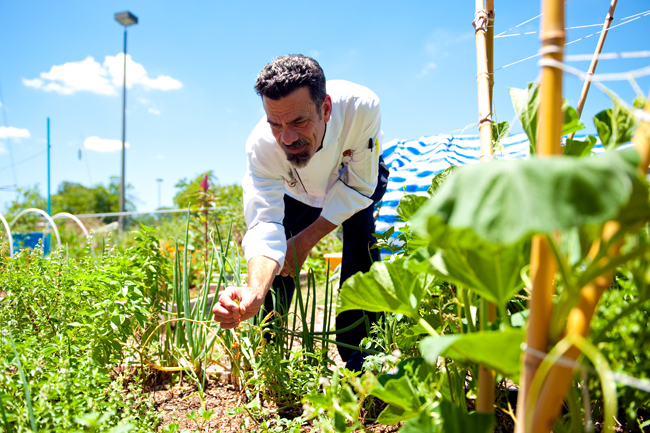UT broke ground on a new food garden this month that will bring more homegrown food to campus plates this fall, an increasingly common practice at Texas institutions looking for sustainable practices during the state’s three-year drought.
Spanning several hundred feet along Brackenridge Hall on 21st Street, the Jester South Garden will produce fruits and vegetables to be served at UT residence halls. The garden will be self-sustaining, supported by rainwater collection and a water pump powered by solar energy. Officials are currently preparing land to plant food in the garden, which could be completed as early as September.
UT officials said although growing their own food comes with cost and weather challenges, the new garden will support various food programs on campus and reduce the University’s dependence on outside providers, which are often plagued by high demand.
The new garden would help the University reach its goal of providing as much local and homegrown food as it can on campus, officials said.
“Organic produce requires a lot more patience, research and understanding of the nature of soil, but we are better off understanding the place we grow and using methods that reduce our footprint and are natural to that environment,” said Hunter Mangrum, an environmental specialist for the Division of Housing and Food Services.
Only 5 percent of commercial institutions nationwide produce their own food, and UT is one of them, Mangrum said. Along with the Jester South Garden, UT also runs the Kinsolving Courtyard Garden on Whitis Avenue and the Concho Community Gardens in East Campus.
The University makes a concentrated effort to obtain any food it does not grow itself from local farms in Central Texas, officials said, which is not always easy because of drought conditions and demand. The National Oceanic and Atmospheric Administration predicted this month that it expects drought conditions in Texas to continue through October.
Officials say sustainable gardens help reduce DHFS’s dependence on the Sustainable Food Center of Austin.
During the 2012-2013 academic year, DFHS obtained 23 percent of its $8 million food budget from local foods grown at farms smaller than 200 acres within a 150-mile radius of UT.
Mangrum said the Jester South Garden will grow a variety of produce. Summer and spring will yield fruits and vegetables while winter will bring potatoes and squashes.
A team of undergraduate and graduate students will be trained in the fall on how to maintain the garden, Mangrum said.
The new garden will also increase support for other food programs on campus, including Farm to Work, which allows faculty and staff to have produce delivered to their workplace every week.
The program has already become very popular, said Claire Moore, a manager in Human Resource Services. Moore said the Jester South Garden would increase the amount of produce available to University employees through the program.
“The employees are really enjoying it, the farmers had a good turnout and they’re happy with the amount of boxes that have been ordered,” Moore said. “We’ve had great reviews and there have been a lot of repeat customers.”
Robert Mayberry, an executive chef and food service manager, will lead the choice of what crops to plant and harvest in the garden.
Mayberry said there would be many challenges ahead for the garden, including the higher costs of small-scale farming and susceptibility to local weather conditions.
However, Mayberry said the garden is still a step up from mass agribusiness that brings in low-cost foods at the risk of heavy chemical practices and practices that damage soil in the long-term.
“Low-cost and abundant food can be looked at as a loan,” Mayberry said. “Someone down the line will have to pay the bill, and it will come due.”
Correction on July 24: A previous version of this article incorrectly stated that the garden would yield fruits and vegetables in the winter. This is incorrect. The garden will yield fruits and vegetables in the summer. The article also stated that the Sustainable Food Center of Austin was DHFS's largest food provider. DHFS is actually the center's largest buyer.





















